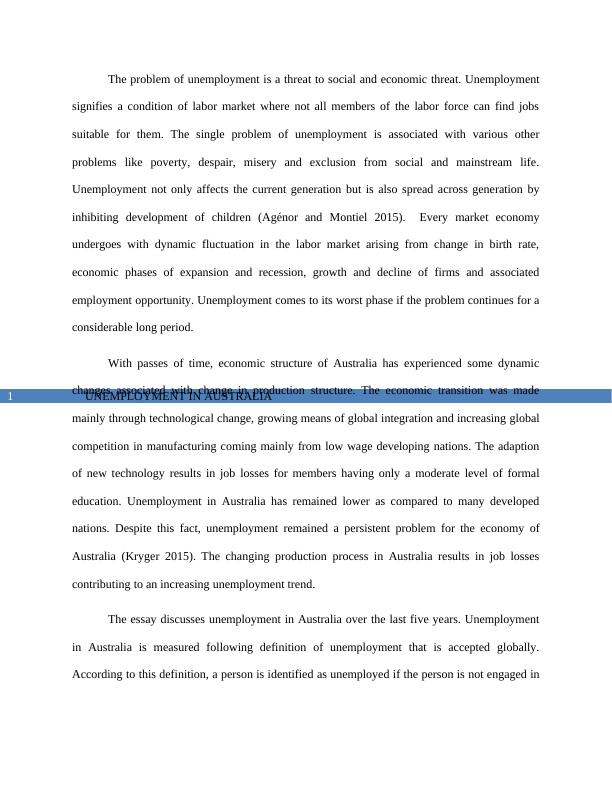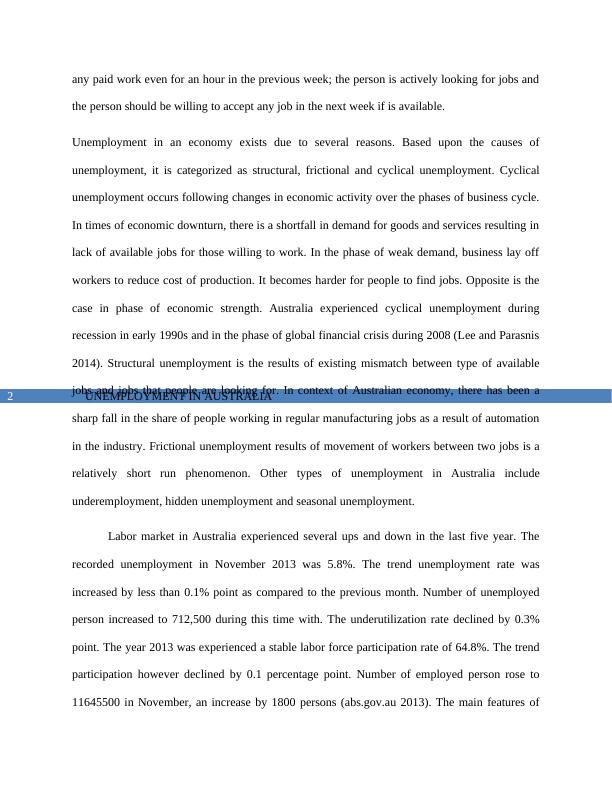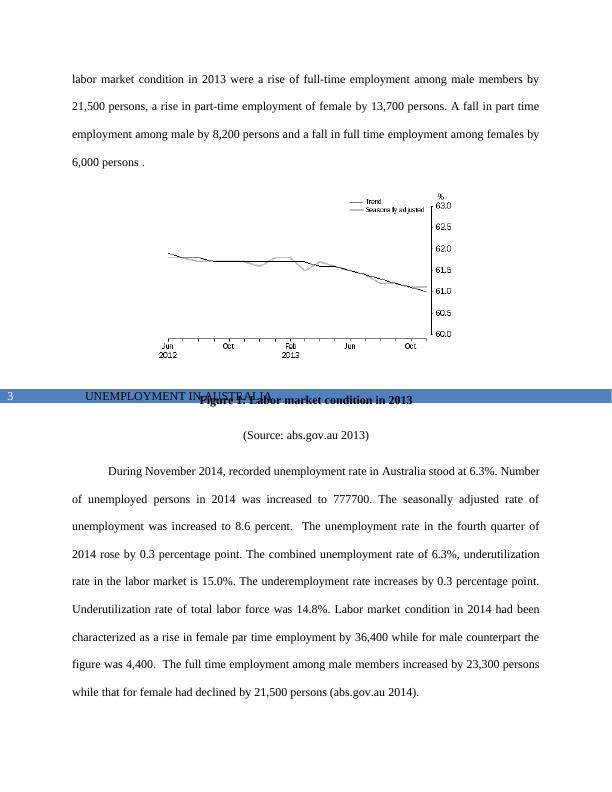Australia's Unemployment (pdf)
Added on 2021-06-14
15 Pages3557 Words37 Views
Running Head: UNEMPLOYMENT IN AUSTRALIA Unemployment in AustraliaName of the StudentName of the UniversityCourse ID

UNEMPLOYMENT IN AUSTRALIA 1The problem of unemployment is a threat to social and economic threat. Unemploymentsignifies a condition of labor market where not all members of the labor force can find jobssuitable for them. The single problem of unemployment is associated with various otherproblems like poverty, despair, misery and exclusion from social and mainstream life.Unemployment not only affects the current generation but is also spread across generation byinhibiting development of children (Agénor and Montiel 2015). Every market economyundergoes with dynamic fluctuation in the labor market arising from change in birth rate,economic phases of expansion and recession, growth and decline of firms and associatedemployment opportunity. Unemployment comes to its worst phase if the problem continues for aconsiderable long period.With passes of time, economic structure of Australia has experienced some dynamicchanges associated with change in production structure. The economic transition was mademainly through technological change, growing means of global integration and increasing globalcompetition in manufacturing coming mainly from low wage developing nations. The adaptionof new technology results in job losses for members having only a moderate level of formaleducation. Unemployment in Australia has remained lower as compared to many developednations. Despite this fact, unemployment remained a persistent problem for the economy ofAustralia (Kryger 2015). The changing production process in Australia results in job lossescontributing to an increasing unemployment trend. The essay discusses unemployment in Australia over the last five years. Unemploymentin Australia is measured following definition of unemployment that is accepted globally.According to this definition, a person is identified as unemployed if the person is not engaged in

UNEMPLOYMENT IN AUSTRALIA 2any paid work even for an hour in the previous week; the person is actively looking for jobs andthe person should be willing to accept any job in the next week if is available. Unemployment in an economy exists due to several reasons. Based upon the causes ofunemployment, it is categorized as structural, frictional and cyclical unemployment. Cyclicalunemployment occurs following changes in economic activity over the phases of business cycle.In times of economic downturn, there is a shortfall in demand for goods and services resulting inlack of available jobs for those willing to work. In the phase of weak demand, business lay offworkers to reduce cost of production. It becomes harder for people to find jobs. Opposite is thecase in phase of economic strength. Australia experienced cyclical unemployment duringrecession in early 1990s and in the phase of global financial crisis during 2008 (Lee and Parasnis2014). Structural unemployment is the results of existing mismatch between type of availablejobs and jobs that people are looking for. In context of Australian economy, there has been asharp fall in the share of people working in regular manufacturing jobs as a result of automationin the industry. Frictional unemployment results of movement of workers between two jobs is arelatively short run phenomenon. Other types of unemployment in Australia includeunderemployment, hidden unemployment and seasonal unemployment. Labor market in Australia experienced several ups and down in the last five year. Therecorded unemployment in November 2013 was 5.8%. The trend unemployment rate wasincreased by less than 0.1% point as compared to the previous month. Number of unemployedperson increased to 712,500 during this time with. The underutilization rate declined by 0.3%point. The year 2013 was experienced a stable labor force participation rate of 64.8%. The trendparticipation however declined by 0.1 percentage point. Number of employed person rose to11645500 in November, an increase by 1800 persons (abs.gov.au 2013). The main features of

UNEMPLOYMENT IN AUSTRALIA 3labor market condition in 2013 were a rise of full-time employment among male members by21,500 persons, a rise in part-time employment of female by 13,700 persons. A fall in part timeemployment among male by 8,200 persons and a fall in full time employment among females by6,000 persons .Figure 1: Labor market condition in 2013(Source: abs.gov.au 2013)During November 2014, recorded unemployment rate in Australia stood at 6.3%. Numberof unemployed persons in 2014 was increased to 777700. The seasonally adjusted rate ofunemployment was increased to 8.6 percent. The unemployment rate in the fourth quarter of2014 rose by 0.3 percentage point. The combined unemployment rate of 6.3%, underutilizationrate in the labor market is 15.0%. The underemployment rate increases by 0.3 percentage point.Underutilization rate of total labor force was 14.8%. Labor market condition in 2014 had beencharacterized as a rise in female par time employment by 36,400 while for male counterpart thefigure was 4,400. The full time employment among male members increased by 23,300 personswhile that for female had declined by 21,500 persons (abs.gov.au 2014).

End of preview
Want to access all the pages? Upload your documents or become a member.
Related Documents
Unemployment in Australia: Trends, Causes, and Government Policieslg...
|15
|3327
|313
Economics For Business - Assignment Samplelg...
|15
|3531
|80
Assignment On Unemployment in Australialg...
|21
|4154
|372
Economics Assignment | Unemployment in Australia Assignmentlg...
|14
|3168
|220
Causes and Policies to Reduce Unemployment in Australialg...
|10
|2348
|178
Impact of Unemployment on Australian Economy: Analysis from 2008 to 2018lg...
|8
|1149
|319
